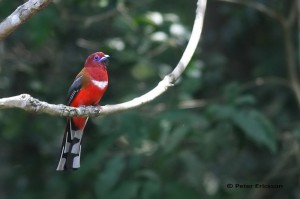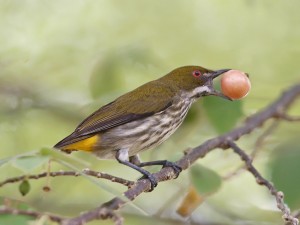Week 37 – 26 March 2017:
The Value of Jhum to Birds
To paraphrase Douglas Adams’ description of airports, it can hardly be a coincidence that no language on Earth has ever produced the expression “As pretty as an oil palm plantation.” I have walked through oil palm plantations in southeast Asia, and I have flown over them. On no scale are these plantations anything other than ugly.
And yet in world where a growing human population puts increasing demands on the landscape, monoculture production of plants such as oil palms and teak are seem as an economic saviour. Cutting down native forests and replacing them with these plantations is certain to force out creatures that are committed to live in the forests. Is there a reasonable alternative?
In the north-eastern states of India lie forests that are recognized as global biodiversity hotspots. Traditionally the indigenous tribal people of the region have utilized a system of shifting agriculture known as jhum cultivation. This form of agriculture involves a systematic rotation of land cleared of trees for cultivation, resulting in a mosaic of active and fallow fields, and regenerating and mature forests.
Jaydev Mandal of Gauhati University and Shankar Raman of the Nature Conservation Foundation in Mysore, India, set out to compare the use of mature forests, jhum, and oil palm and teak plantations by forest birds. Their study was conducted in the Dampa Tiger Reserve, the largest protected area in the state of Mizoram. It is a rugged and hilly region. The core of the reserve is free of human settlement, but a number of villages are found around the reserve’s margin. Increasingly the jhum system of cultivation in the area is being replaced by monoculture plantations, with the support of the state government.
Mandal and Raman conducted surveys in March and April of 2014, when the area was occupied by both migrant and resident birds. They recorded over 1300 individuals of 112 species, most of which were forest specialists including the Red-headed Trogon, the Gray-throated Babbler, the Wreathed Hornbill, and the Pale-chinned Blue-flycatcher.
It will surprise no one that oil palm plantations supported the fewest bird species. These plantations have almost no native trees, and are structurally simple. Teak plantations were a bit more useful to birds. Again it is no surprise that the intact native forests had the greatest number of birds of the greatest number of species. “Jhum was thus intermediate between plantations and mature rainforests in habitat structure, bird community composition, and conservation value,” wrote Mandal and Raman.
What does the future look like for birds in north-eastern India? Nothing beats an original intact operating ecosystem, but we live at a time when that is not always an option. Currently the Mizoram State Government’s New Land Use Policy aims to eliminate jhum cultivation, replacing it with other land uses. Given the apparent value of jhum for birds like the Pale-headed Woodpecker and Yellow-vented Flowerpecker, perhaps the state government might help farmers to refine their practices, rather than replace that form of cultivation.
Mandal, J., and T. R. Raman. 2016. Shifting agriculture supports more tropical bird forest birds than oil palm or teak plantations in Mizoram, northeast India. Condor 118:345-359.
Photo credits: Red-headed Trogon, photographed by/© Peter Ericsson (www.pbase.com/peterericsson/profile) – www.phuketbirdwatching.com; Yellow-vented Flowerpecker, photograph/© by wokoti - www.flickr.com/photos/wokoti/4821960569



